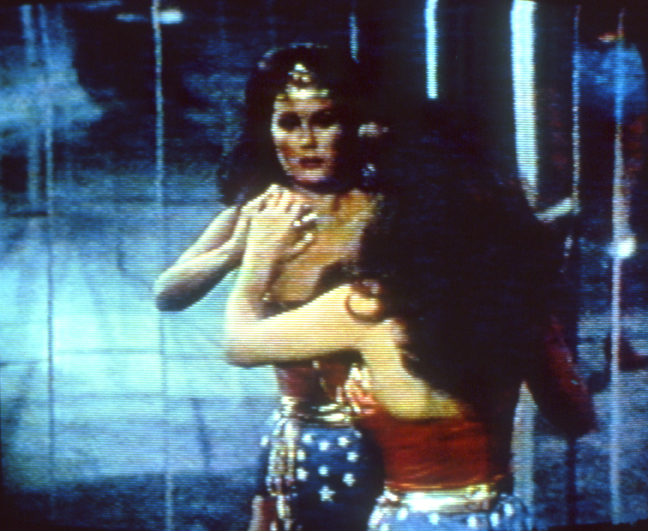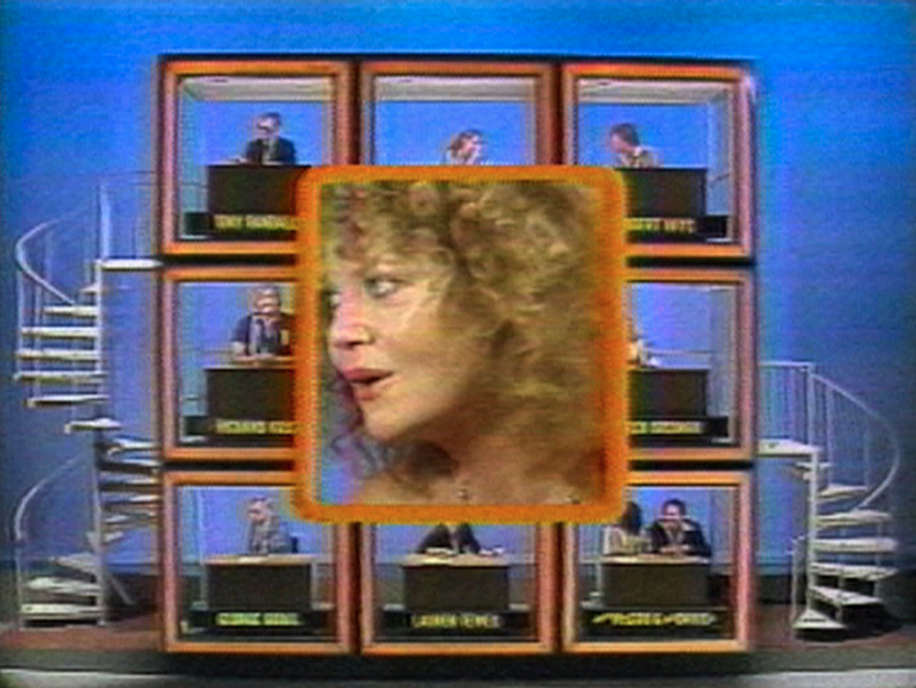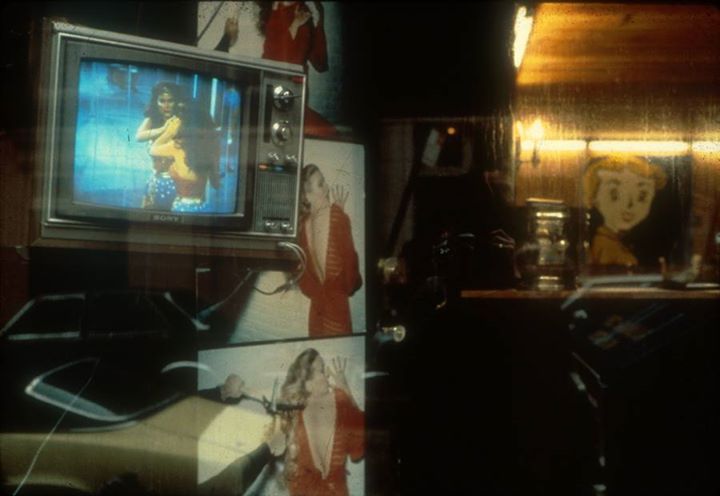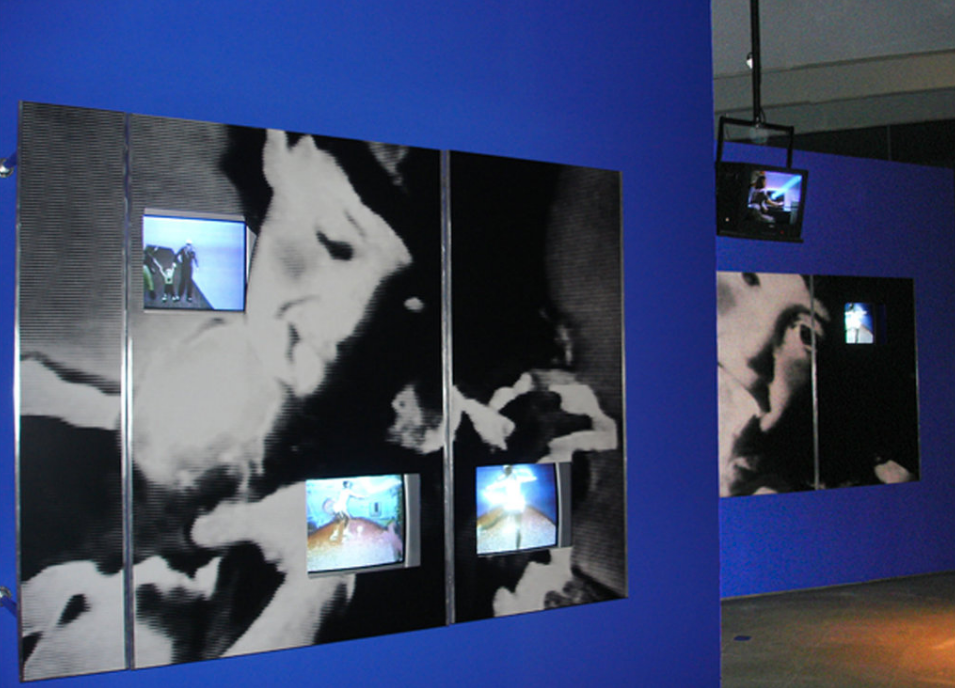Dara Birnbaum: St. Louis Art Museum
by Brian Prugh
We’re a long way technologically from the genesis of Dara Birnbaum’s Technology/Transformation: Wonder Woman and Kiss the Girls, two works created in the late seventies and currently showing at the St. Louis Art Museum as part of its New Media Series, curated by Hannah Klemm. Both works were innovative for their use of captured (appropriated) television footage, well before the invention of equipment that made recording television commonplace and widely available. This is a crucial point for appreciating the original context of the works: when they first appeared, television was a one-way stream of images and sound, created and broadcast by the networks only to pass through the television screens of millions of homes and then out into the ether.

How startling it must have been, then, to see some of these images and sounds captured, cut up, and re-projected back in the general direction of the networks. When Technology/Transformation: Wonder Woman was shown at an upscale SoHo hair studio in 1979, it must have seemed like there was one TV on the island that wasn’t working—TV skipping like a scratched record.
Now, approaching forty years later, the innovations in the work have been incorporated into what has become a more totalized media experience. While Birnbaum’s intention to “talk back” to TV once seemed radical, social media makes it the case that today anyone can “talk back” to TV whenever they want to (and many do). The novelty of capturing a brief cut of a show and repeating it over and over has also worn off. How many GIFs accomplish the same effect? The pop cultural references are sufficiently distant enough so as to require some research by those viewers (like me) who do not remember first-hand footage of Wonder Woman or Hollywood Squares.

This distance leaves a question for the two works on view: if the cultural content has grown remote, and the technological and formal innovations have become commonplace, what remains in these works to command our interest? That plenty remains is borne out by recent scholarship, which has mined the work in feminist, psychoanalytic, and deconstructive terms.1 But what was most palpable in watching the videos in the museum was an imperative to turn off the TV: I was surprised by their potency as an antidote to the TV show as an entertainment form.
Technology/Transformation: Wonder Woman uses footage from the television show to splice cuts—often repeated four, five or even ten times—distilling the show into five minutes and fifty seconds, a third or so of that at the end dedicated to playing a disco song, “Shake thy Wondermaker!” Repeating the exciting parts of the show: a fiery explosion, a special effects-heavy transformation sequence as Diana Prince (mild-mannered office worker) spins to transform into Wonder Woman, her running vigorously through a landscape or deflecting bullets with her bulletproof bracelets. All of the temptations that come along with the high-powered action series (its strong female lead, at that) are there—but so is the devastating banality of it all.

For Birnbaum, the plot is boiled down into a single five second interchange with the male character Wonder Woman is rescuing: “We have to stop meeting like this.” This manages to say it all: they have met like this before, and Wonder Woman will meet this man (or some other suitably helpless stand-in) “like this” again in every other episode. This exhausts the narrative development of the show, making starkly visible the enormous waste of time that is the rest of the plot.
Kiss the Girls performs the same operation on the daytime television show Hollywood Squares—a gameshow where Hollywood stars appear “as themselves” to answer questions within the context of a gameshow. Birnbaum splices together shots of the women on the show with canned expressions of feigned sincerity that are unbearably artificial and that reinforce the ugliest stereotypes imaginable about the interior lives of the women that enact them. There are also brief cuts representing two men that appear to be no less soulless. Watching the actors shrink into stereotypes of themselves in the video is terrifying, and loses none of its force with the age of the images. In fact, this particular video might be growing in potency, as the dated hairstyles and conventions no longer appear novel or normative—the hideousness of the contorted poses the “stars” take all the more apparent without the veneer of contemporary style.

What I appreciate most about these works is that they do not attempt to carve out a space for affected irony about TV, where one can feel good about watching if it is done in a sufficiently aloof way. There is more at stake here: more than a critique of a few problematic conventions, Birnbaum’s potent reduction of the medium calls on us to question the system itself, and wonder if, perhaps, it is better to turn away.
Dara Birnbaum, Technology/Transformation: Wonder Woman and Kiss the Girls at the St. Louis Art Museum runs through December 11, 2016.
- A flurry of scholarship that addresses these works cropped up a few years ago, including the catalog for Birnbaum’s 2009 retrospective at the Stedelijk Museum voor Actuele Kunst and a 2010 monograph on Technology/Transformation: Wonder Woman. Karen Kelly, Barbara Schröder and Giel Vandecaveye, eds., Dara Birnbaum: The Dark Matter of Media Light (Ghent: S.M.A.K, 2009). Also, T. J. Demos, Dara Birnbaum: Technology/Transformation: Wonder Woman (London: Afterall Books, 2010).